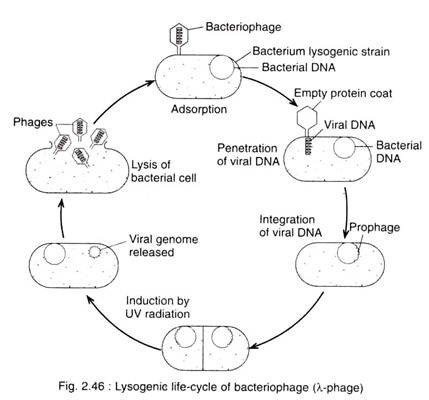The phage virus can be the reason for the lysis of the bacteria in the lytic cycle. Such viruses are called lytic or virulent phage. The lytic cycle is divided into the following steps:
1. Attachment or adsorption
The Bacteriophage is attached to the receptor site on the cell of the bacterium. Weak chemical union takes place between the virus and receptor site.
2. Penetration
The tail of virus releases lysozyme enzyme.it dissolves a small part of the bacterial cell wall. The tail sheath contracts and pushes the tail core into bacteria through its cell wall and cell membrane. The virus injects its DNA into the bacterial cell-like syringe. The protein coat ( tail and head ) of the virus left outside the cell wall. However, many animal viruses enter the host as a whole.
3. Multiplication
The viral DNA starts controlling the biosynthetic machinery of the bacteria inside the bacterial cell. It uses the bacterial cell to build the parts of the virus, protein, and DNA. Then virus multiplies to form many new viruses.
Approximately 200 new viruses formed after 25 minutes of the infection.
4 Lysis
Many viruses are formed in the bacteria. The bacterial cell undergoes lysis and bursts. The newly-formed viruses are escaped and infect other bacteria.

Lysogenic cycle
The phage does not always destroy bacteria. Sometimes, it lives peacefully inside the bacterial cell. These do not control the biosynthetic machinery of the host cell. The viral DNA incorporated into the bacterial chromosome. The phage in this state is called a prophage. The process is called lysogeny. The bacteria continue to live and reproduce normally in this condition. It passes to each daughter cell in the coming generation. Sometimes, the viral DNA detaches from the bacterial chromosome and starts the lytic cycle. This process is called induction. The lysogenic bacteria are resistant to viral infection by the same or similar phage virus. The phage in which cases lysogeny is called temperate or lysogenic phage. The phage possesses a gene code for a repressor protein. This protein represses the replication of phage DNA in the lysogenic cycle. Repressor proteins save the bacteria from lysis.

